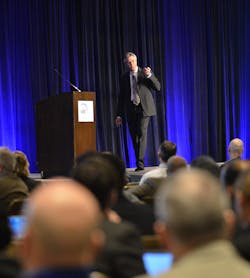It’s been about three years since the launch of The Open Group’s Open Process Automation Forum (OPAF), which was formed in response to a request—or more like a demand—from ExxonMobil to create open systems for process control. Specifically, the company was tired of the vendor lock-in related to closed proprietary systems, and asked industrial control system (ICS) suppliers to move toward standards-based, open, secure, and interoperable process automation architectures.
It was a bold request, but already a proven concept based on The Open Group’s existing initiative—the Future Airborne Capability Environment (FACE) consortium—a government and industry partnership that defined an open avionics environment for all military airborne platforms. And, with some of the biggest ICS suppliers agreeing to cooperate on a similar effort in process control, OPAF was born.
Today, total OPAF membership stands around 135 companies. “And we are still growing,” says OPAF director Ed Harrington. “It’s a blessing and a problem all at the same time. With new members, you have to start all over and go over things multiple times. But the outcome is worth it because we get good participation, good insights, and good efforts from the team that is working on not only the technical side, but the business side as well.”
In the beginning, the group identified key areas to address, including understanding value-chains and business models; developing a “standard of standards” that would not reinvent the wheel, but leverage existing standards to deliver interoperability and application portability; and outlining a conformance program to identify products that comply with the standards created by the forum.
When gathering a group of suppliers—who are competitors—along with end users, integrators, and academics there is a sense that there would be so many conflicting agendas and opinions that not everyone would play nice in the sandbox and, therefore, no work would get done. But since 2017 when these goals were first outlined, there has been actual activity:
• In February of 2018 the first deliverable, the Open Process Automation Business Guide, was introduced, explaining the value proposition and business case for the development of an open framework.
• In February of 2019, the group released a preliminary version of the open process automation standard (O-PAS) v.1.0, which specifically addresses the issue of interoperability.
• In June of 2019, OPAF held an interoperability workshop with about 15 suppliers. This “plugfest” was done to test out the O-PAS standard with different prototypes, providing feedback to continue development.
• In July 2019, ExxonMobil announced a parallel effort and signed a collaboration agreement with six other companies, including Aramco Services Company, BASF, ConocoPhillips Company, The Dow Chemical Company, Georgia-Pacific LLC, and Linde PLC to accelerate the development of open process automation (OPA) systems. Separate from the OPAF efforts, the team, which selected Yokogawa as the main automation contractor (MAC), has been working on an OPA test bed, scheduled to go live at the end of 2019.
• In February 2020, O-PAS v.2.0 will be released, with a focus on configuration portability, the first steps toward the ultimate goal of plug-and-play of control equipment.
“Version 2 is more full-featured and there are some significant areas addressed, one being cybersecurity,” said Dave Emerson, vice president of the U.S. Technology Center at Yokogawa and co-chair of the enterprise architecture working group at OPAF. “And we are going to be using some work that is jointly being developed by the FieldComm Group and OPC Foundation.”
The work Emerson mentioned is the process automation device information model (PA-DIM), which FieldComm and OPC Foundation announced in 2018, working together toward a protocol independent specification to implement the requirements of the NAMUR Open Architecture (NOA), and with Profibus & Profinet International also participating. The O-PAS standard will adopt that, as well. “We fed some information back to FieldComm and OPC, so it is a cooperative and iterative effort,” Emerson said.
Moving forward, a new version of the O-PAS standard will roll out every year and plugfests will continue. When asked what obstacles the group has had to overcome to get this far, Yokogawa’s Emerson says there has not been any huge stumbling blocks. “The biggest surprise is how few obstacles there are. You get 10 engineers in a room and you’ll get 20 different ways to do something. But this group is action-minded and everyone feels it is the right time technology-wise and market-wise to do this.”
However, not everyone agrees that this open architecture approach is a good thing.
Conflicting opinions
There are still two major ICS suppliers who are OPAF holdouts. Emerson and Honeywell.
Emerson joined the group in the beginning but backed away due to concerns about protecting its intellectual property (IP). In an interview last year, Peter Zornio, CTO at Emerson Automation Solutions, told Automation World:, “It’s an open group with an unprecedented broad scope for a standard, so the sky’s the limit on what you donate for IP, which makes me concerned.”
OPAF representatives maintain that IP is not at risk. “We’re not exposing IP with this initiative,” said Trevor Cusworth, ExxonMobil strategic account manager at Schneider Electric and the OPAF co-chair.” All we’re exposing is the interface to the components.”
Nevertheless, Zornio recently said: “Our position hasn’t changed. We are still monitoring what’s happening, but not actively part of [OPAF].”
Honeywell, on the other hand, claims to be an OPAF participant, but is not listed as a member. Honeywell has a very long history with ExxonMobil which has a large installed base of its legacy distributed control system (DCS), the TDC 3000, a state-of-the-art DCS in 1985. As several key hardware components approach end of life around 2025, ExxonMobil was facing a major upgrade, and challenged Honeywell to solve the problem to avoid massive rip and replace.
Honeywell responded with the release of the Experion LCN (ELCN) R501.1 in 2018, which virtualizes legacy hardware nodes as software, enabling the decades-old platform to run on any current hardware.
This solved the DCS obsolescence problem for ExxonMobil, but industry observers wonder if such an offering negates the need for OPAF’s open architecture.
“It doesn’t solve the same problem as OPAF’s vision, which is to eliminate the proprietary silos all vendors have,” said Harry Forbes, a research director at ARC Advisory Group. But it does keep ExxonMobil and others running TDC 3000 from having to deal with the rip and replace nightmare, he said. “I advise my end-user clients to prepare for more products like the ELCN in the future DCS market. Emulation of TDC 3000 took some serious work…I expect several other suppliers to introduce emulations or virtualizations of both their legacy and their most modern control products. Honeywell won’t be the last to do this by any means.”
After the Honeywell ELCN announcement, Don Bartusiak, chief engineer for process control at ExxonMobil, and OPAF co-chair, released a statement that said, “ExxonMobil’s commitment to OPA is unequivocal. OPA directly addresses the root causes of the business problem that we and other operating companies are trying to solve.”
And, while there is no doubt that ExxonMobil is 100% behind the OPA effort, some individuals are raising new questions about what this means for end users.
Innovating in an open architecture
Sandy Vasser, who retired from ExxonMobil in June 2016, was working as the manager for the IC&E group on the upstream side of the organization when the original OPA movement was initiated by the downstream side. His group exchanged ideas on the progression of the process control during that time, and he stays informed on the developments of OPA. He also has personal opinions on how the developments may impact the industry and its end users.
In a recent post from Vasser on LinkedIn titled “Open Systems: Be Careful What You Ask For,” he states that a move to open systems in process control could have many unanticipated and unintended consequences. Specifically, if system suppliers decide to divert their focus from complete systems to select components, they may decide to end the time and money spent on system engineering and development. Yet, with an increased number of component suppliers, there will be a growing need to evaluate the suppliers and the components. That means, the end user will have to accept the responsibility and cost for assessments and testing.
OPA will also likely remove the strategic advantage the system suppliers have when providing MAC services for systems consisting primarily of their components and may even eliminate the MAC services by the system suppliers—which often leads to new products, services, and technology improvements. And, many of the automation problems that need to be solved are system related, not component related; but users are not in the business of designing and manufacturing control systems to fill the gaps in services currently provided by the system suppliers, Vasser said.
“In the many discussions I’ve had with [individuals at ExxonMobil], they believe that the cost of maintenance will go down with OPA,” Vasser said in an interview with Automation World. “When you consider all of the development activities and services that will shift from the system suppliers to the users, I am not convinced the costs will go down. I think the burden on the users will go up. The OPA proponents need to address the gap of who will provide all of the R&D and development services for systems in an OPA environment.”
That could lead to another unintended consequence: a decline in the pace of innovations.
“In an OPA environment, where users have complete control over the system designs, they will also have complete control over most innovations and their adoption. And I think the pace of innovation developments will decline if the industry goes to a complete OPA environment because of the decline of total R&D,” Vasser said.
While understanding the architectural vision that the ExxonMobil downstream team had, which was based on FACE, the technical standard for the military, he feels the adoption into the process industries will be more challenging.
“In the defense industry there is one client, the U.S. [military]. So all they have to do to come up with a solution is to get an agreement from one client. In the process industry there are literally thousands of clients all with different ideas of how to do it,” said Vasser.
And, while Vasser does believe OPA could result in a proven offering given the number of companies engaged—including other large oil and gas manufacturers and major technology suppliers—he’s not convinced that it will become the next big thing for the general population of process automation users. “I think it may become a solution for a few major users who have large automation organizations that can do most of the things that the major system suppliers do today, but they are probably the only ones that have the internal infrastructure to realize the potential benefits.”
To that end, because much of the development and motivation has been initiated in oil and gas, it’s still not clear how O-PAS will apply to other process industries. Currently, OPAF members are companies in oil and gas, chemical, and pulp and paper. But food and beverage has yet to stake a claim in the initiative. Therefore, OPAF leaders are working on ways to make this universally appealing to all continuous and batch processing industries.
“We’ve written business scenarios for each industry, including pharma, and we’re adding one now for food and beverage,” said OPAF co-chair Cusworth. “We show how this will affect you and benefit you specifically, but there’s also a lot of commonality between all the industries. From big breweries using DCS to small bakeries using PLCs—we got input from those industries to help craft those business scenarios.”
But in order for the OPAF architecture to succeed, the group needs critical mass. “We need more end users,” said Cusworth.
Leaders relevant to this article:


